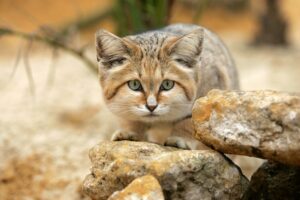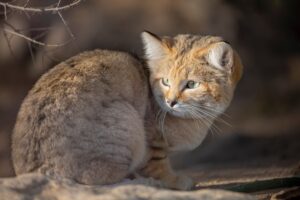Sand cat facts, (Felis margarita), The Desert Cats Adaptations
Sand cat (Felis margarita): Few felines spend all of their lives in the desert, but sand cats are designed for this harsh environment. Their skull is shaped to facilitate hearing so they can listen for predators and prey across the vast, open expanse of their home range.
Sand Cat – The Desert Cats
Sand cats are aptly named because they live entirely in desert environments, a place often associated with sand. These felines subsist from dunes to rocky, sparsely vegetated outcrops and often don’t even need a reliable source of water to stay alive; they get most, if not all, of their moisture from their food!
Sand Cat Range & Behaviour
Sand cats live in fragmented populations across northern Africa, the Arabian Peninsula, and southwest and central Asia, though it’s worth noting they’re tough to find, so they may have a wider distribution. They’re crepuscular or nocturnal depending on the time of the year, often transitioning their behavior with that of their prey.
Sand cats are not sit and wait predators, they actively hunt down meals such as rodents, lizards, birds, and sometimes even insects, walking as far as a few miles (5 km) each night. Their stocky legs keep them low to the ground and out of sight of potential predators.
Sand Cat Predators
Although they’re predators themselves, sand cats aren’t very large. Weighing about four and a half to six and half pounds (2-3 kg) on average, with males outweighing females, these felines fall prey to larger predators such as golden eagles, caracals, jackals, wolves, and even domestic dogs and cats.
Sand cats are classified in the same genus as our domestic house cats and they have even been documented to show little fear of humans. If caught in the beam of a person’s flashlight, a sand cat closes its eyes to disguise the glow of reflected light in its eyes.
Sand Cat Burrow
During the day, sand cats use burrows to snooze. They share burrows across a range but not at the same time– these animals are mostly solitary. A mating pair may bunk up together for a short while and a mother cares for her kittens, but otherwise they’re on their own. Dens are dug by the sand cats themselves or expanded from previous occupants such as porcupines and even small rodents. Sand cats have dense fur which may seem counterintuitive for hot desert-living, but remember this habitat can become just as frigid at night as it is hot during the day.
Sand Cat Adaptations
Air temperatures can soar well over 100 degrees Fahrenheit (38 degrees Celsius) at the hottest parts of the year down to below freezing in the winter months. Sand cats actually develop a thick winter coat they must shed each year with warming temperatures. They also have dense tufts inside their ears to keep sand from entering. Their paw pads are covered in fur as well which helps give them traction on sand and avoid burning their beans – I’m sure many of you have taken a barefoot step on super hot sand and wished you had shoes on instead!
Sand Cat Threats
This trait also makes them difficult to track. Sand cats are considered rare. They’re difficult to find due to their cryptic nature, so there may be more out there just avoiding humans, though current estimates suggest their population is declining overall. Run-ins with domestic cats could be a contributing factor to this as feral felines can carry transmissible diseases to the unprotected sand cats. If they survive to adulthood, sand cats can typically live about eight years in the wild and up to double this in captivity.
Sand Cat Life History
They’re not seasonal breeders and are capable of producing more than one litter per year. Litters are typically three kittens which are born blind. It takes two weeks for them to open their eyes, another week to start walking, and three more weeks before they begin eating solid food. They are reproductively mature when they become independent at about nine months of age.
